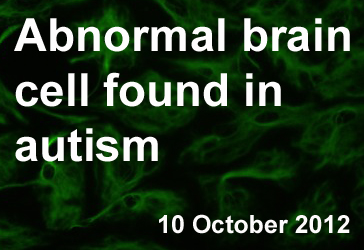Check out other stories from the Latest News
Atypical Astrocytes Found in Brains of ASD Patients
By Mark N. Ziats on October 26, 2012

Background:
The brain is the main organ responsible for controlling the complex processes that govern human behavior. The brain contains both neurons—the cells responsible for transmitting chemical and electrical signals throughout the brain—and glia—a population of cells that provide various supporting roles in the brain. Until recently, very few studies focused on the role of glia in Autism Spectrum Disorder (ASD).
What’s new:
In a recent study published 21 September 2012 in the Journal of Neuroinflammation, researchers found abnormalities in glial cells known as astrocytes in brains from autistic children. Using post-mortem brain tissue from six autistic patients and six age-matched controls, the researchers discovered that astrocytes from autistic brains were abnormal in size, shape, and number. Additionally, brains from a common mouse model of autism showed similar astrocyte defects. Upon further investigation, the researchers found that a molecular pathway thought to be involved in astrocyte development (called the Wnt/Β-catenin pathway) was decreased in the brain samples of autistic patients.
Why it’s important:
Both neurons and glia play an important role in the functioning brain. By understanding how each cell type links to the core behaviors seen in autism and knowing which molecular pathways may be aberrant in those cells, researchers can better target effective therapies. Both human and animal studies will play an important role towards this goal.
Help me understand :
| Source(s) : |
| Tweet |

